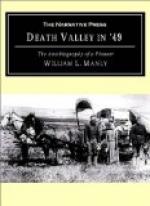The miners shovel dirt into the upper end of the boxes slowly, and regulate the water so that it dissolves the lumps and chunks very thoroughly before it reaches the long tom where a man stands and stirs the gravel over, and if nothing yellow is seen throws the washed gravel away, and lets the rest go through the screen. Immediately below this screen was placed what was called a “riffle box,” 2 by 4 feet in size with bars 4 inches high across the bottom and sides, and this box is set at the proper angle. Now when the water comes through the screen it falls perpendicularly in this box with force enough to keep the contents continually in motion, and as the gold is much heavier than any other mineral likely to be found in the dirt, it settles to the bottom, and all the lighter stuff is carried away by the water. The gold would be found behind the bars in the riffle box.
These methods of working were very crude, and we gradually became aware that the finest dust was not saved, and many improvements were brought into use. In my own mine the tailings that we let go down the mountain side would lodge in large piles in different places, and after lying a year, more gold could be washed out of it than was first obtained, and some of it coarser, so that it was plainly seen that a better way of working would be more profitable. There was plenty of ground called poor ground that had much gold in it but could not be profitably worked with the rocker and long tom. The bed rock was nearly level and as the land had a gradual rise, the banks kept getting higher and higher as they dug farther in. Now it was really good ground only down close to the bed rock, but all the dirt had some gold in it, and if a way could be invented to work it fast enough, such ground would pay. So the plan of hydraulic mining was experimented upon.
The water was brought in a ditch or flume to the top of a high bank, and then terminated in a tight box. To this box was attached a large hose made by hand out of canvas, and a pipe and nozzle attached to the lower end of the hose. Now as the bank was often 100 feet or more high the water at this head, when directed through the nozzle against the bank, fairly melted it away into liquid mud. Imagine us located a mile above the river on the side of a mountain. We dug at first sluices in the rock to carry off the mud and water, and after it had flowed in these a little way a sluice box was put in to pass it through. These were made on a slope of one in twelve, and the bottom paved with blocks, 3 inches thick, so laid as to make a cavity or pocket at the corner of the blocks. After passing the first sluice box the water and gravel would be run in a bed rock sluice again, and then into another sluice box and so on for a mile, passing through several sluice boxes on the way. Quicksilver was placed in the upper sluice boxes, and when the particles of gold were polished up by tumbling about in the gravel, they combined with the quicksilver making an amalgam.




